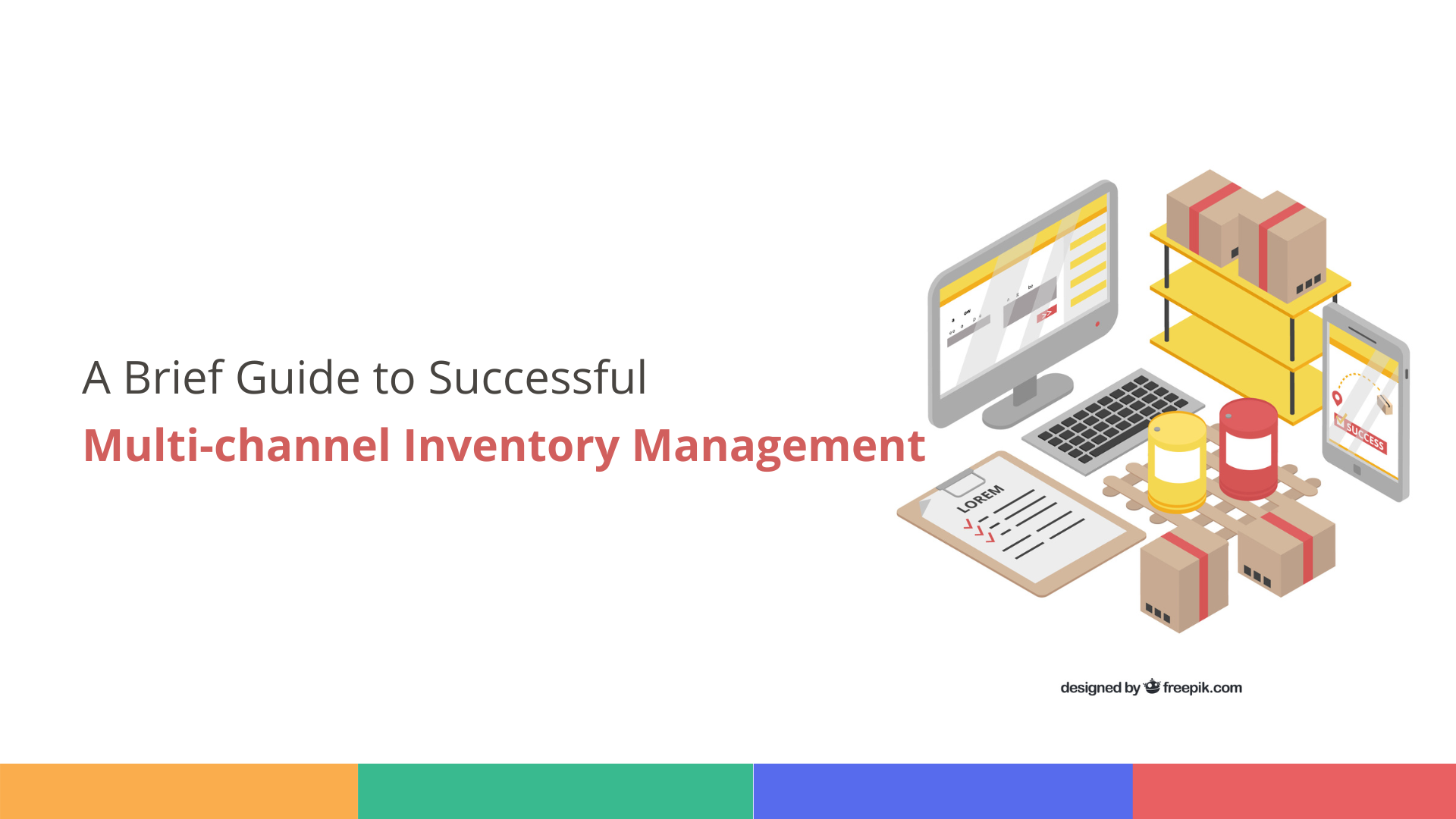Multi-channel inventory management includes monitoring and managing inventory from various sales channels, including multiple marketplaces like eBay, Amazon, Etsy, Flipkart, own website, and social media platforms. Each of these channels offers businesses unique opportunities to connect with customers, increase brand visibility and sales, and thus helps in creating a seamless shopping experience.
Keeping track of the visibility of stock levels and updating data in real time can be challenging for a seller as it consumes significant time and effort. When the number of SKUs is large, managing it manually becomes almost impossible.
For example, if you sell T-Shirts on an ecommerce site eBay, Amazon, Etsy and your own website, if a certain quantity is sold on Amazon, you will need to update the reduced quantity on other channels immediately. Now, just imagine if you have more than 50 SKUs, how difficult it will be for a seller to maintain this data accurately. Accurate inventory management is essential to make informed inventory levels and purchasing decisions.
Advantages of Effective Multi-channel Inventory Management
- Effective multi-channel inventory management ensures that products are available for customers to purchase when they want them, preventing stockouts and lost sales. At the same time, it also helps to minimize overstocking and holding costs. High-volume, fast-growing brands use multi-channel inventory management solutions that synchronize inventory across channels and provide real-time visibility from a centralized dashboard that makes it easy to manage inventory.
- Effective inventory management enables businesses to plan their advertising, promotional and marketing strategies, ensuring that they promote products that are readily available for purchase. With accurate and updated inventory information, businesses can also track the performance of their advertising campaigns and make informed decisions about product promotion, pricing, and advertising spend. This helps optimize return on investment in advertising and improve overall profitability.
Challenges in Multi-channel Inventory Management
It is crucial to track what’s selling where, how many and where and at what time when orders are flowing through Amazon, eBay, Shopify, and your own website. You need to make sure you are not overselling on a particular channel and running out of stock on another online ecommerce platform. Practically, a time comes when you end up spending more time on manual operational activities than growing your business.
Also, order fulfilment across channels requires a clear understanding of inventory quantities and locations in real-time. Without real-time visibility, stockouts, deadstock, and preventable returns are more likely to occur. Sellers with large product stock with multiple SKUs on multiple channels have many moving components in the inventory, creating challenges related to visibility which in turn leads to poor inventory quality. Additionally, the lack of total control results in cancelled order, understocking, overselling, late deliveries and various other issues. Things may seem going out of hand, negatively impacting sellers’ reputation. An ODR (Optimum Defect Rate) exceeding 1% may result in account suspension on Amazon.
Best Practices for Successful Multi-Channel Inventory Management
- Accurate forecasting and real-time tracking of inventory levels for effective order management
By effectively managing their inventory, businesses can minimize the risk of stock shortages, which can result in lost sales and damage to customer relationships. On the other hand, having too much inventory ties up valuable resources and can result in increased storage costs. Effective inventory management can help sellers to optimize their supply chain and reduce waste, as they are able to better plan for the materials and products they need, when they need them. Additionally, having real-time visibility into inventory levels allows sellers to quickly respond to changes in demand and make informed decisions about purchasing and production. Overall, it is crucial to the success of any ecommerce business, as it enables them to provide customers with the products they want, when they want them. - Centralized inventory management
Another important principle of successful multi-channel inventory management is making a centralized inventory management hub for all your channels. It allows sellers to have a holistic view of their inventory levels, making it easier to identify any issues and make adjustments as needed. Centralized inventory management also makes it easier to synchronize inventory across channels, ensuring that products are available for customers to purchase when they want them. Additionally, it allows businesses to make the most of their sales and marketing efforts by ensuring that products are available on all channels and can be promoted effectively, resulting in increased sales. - Regular review and adjustment of the strategy
A final fundamental principle of successful multi-channel inventory management is the regular review and adjustment of the strategy. It means regularly analysing inventory data and making necessary reconciling to ensure that inventory levels are aligned with business goals and customer demand. Periodically reviewing and adjusting the inventory management strategy allows businesses to stay agile and adapt to market and customer demand changes. It also helps to ensure that inventory levels are optimized, reducing the risk of stockouts or overstocking and ultimately increasing the efficiency of inventory management. - Implementation of Automation
Implementing automation in inventory processes is crucial to achieving efficiency in multi-channel inventory management. Furthermore, integration with other systems, such as customer relationship management, accounting, and shipping, is also essential for streamlining multi-channel inventory management. This integration grants businesses a comprehensive view of their inventory, sales, and customer data, enabling them to make well-informed and data-driven decisions, thus improving their operations’ overall effectiveness and efficiency.
Tool And Technologies for Multi-channel Inventory Management
In today’s rapidly evolving business environment, having a multi-channel inventory management system is essential to stay on top of your inventory across various sales channels. This can be achieved by utilizing various tools and technologies, such as inventory management software, e-commerce platform integration, and other advanced solutions.
- Multi-channel inventory management software systems
These systems enable businesses to monitor and control their inventory levels across all channels in real time, guaranteeing they can always fulfil customer demand. This is especially imperative for companies that operate in highly competitive markets, as it allows them to adapt to changes in demand and prevent stockouts promptly. Furthermore, multi-channel inventory management systems can aid organizations in optimizing their pricing strategies across different channels and enhance their overall supply chain efficiency. In summary, implementing these systems can result in improved customer satisfaction, increased revenue, and reduced operational costs. - Integration Tools for Ecommerce Platforms
Integrating technologies with e-commerce platforms has become an essential aspect of multi-channel e-commerce operations. These technologies allow businesses to synchronize their inventory, sales, and fulfillment processes across all their sales channels, ensuring a seamless and consistent customer experience.
Businesses can also use these technologies to automate their pricing strategies, enabling them to adjust prices based on demand, competition, and other factors. Furthermore, these integration technologies also provide businesses with valuable insights into customer behaviour and preferences, enabling them to make data-driven decisions about pricing optimization, inventory optimization and many other aspects pertaining to multi-channel ecommerce management. - Multichannel Order Management System
Order Management System ( OMS) is directly correlated with inventory management.
– Streamline processes, automate manual tasks, and provide real-time visibility into inventory levels, leading to increased efficiency and reduced waste.
– Integrates with various sales channels such as online stores, brick-and-mortar stores, and marketplace sellers to provide a comprehensive view of inventory levels across all channels.
– Provides insights into inventory performance and suggests ways to optimize inventory levels. It also streamlines inventory processes by automating manual tasks such as counting inventory and updating stock levels.
Conclusion
The complexities of managing inventory across multiple channels, coupled with the added challenges of the pandemic, have made it more critical than ever for businesses to optimize their inventory to provide superior customer experience. An inventory management tool can optimize costs associated with mismanaged stocks, avoid stockouts and overselling, and provide actionable insights to optimize warehousing capabilities and better understand the business and customers.


